Welcome to the keyword research tutorial! In this article, we are going to teach you how to research and choose valuable words step by step along with practical examples.
If you know what keyword research is and why we need it, skip the initial sections and get into the groove with the help of the list below.
Let’s start 🙂
Note: According to your wishes, practical and step-by-step research method based on our experience was added to this article on May 3rd, 2023 to help you choose the best words.
What is the keyword?
Everything you search in search engines contains keywords. Suppose you want to design a website but you don’t know how to design it. The easiest and fastest way is to google. You might just type in “site design” or you might be more specific by writing “free website design”. Let’s go one step further! Perhaps, using “How do I design a store website with WordPress?”, you can describe exactly what you need.
A keyword in the field of SEO refers to the words that a searcher uses to find what he is looking for. These words are divided into 2 categories:
Short keywords (Focused) which are single or double words and cover more content.
Long tail keywords that are composed of several words. These expressions express the subject in a specific and more limited way. Their search volume is much lower than the first group; But it helps you find customers who really need you and know what they want!What does keyword research mean?
Keyword research is the process of finding and analyzing words and phrases that potential customers use to find the information they need, research and buy. This process consists of several steps, which we will talk about in detail below, and finally, it will make you know your audience better, find the capacities, know what is left unanswered in this market and how you can get Google. Get the most out of it.
Why is keyword research important?
It’s very simple! If you write content on a topic that no one will search for, you will not get any traffic from Google.
It is better to say that you write for yourself and maybe one day someone will see it. Of course, you can go for advertisements to increase its traffic; But when its search volume is very low in a month, what is the use for you?
Many website owners make this mistake. The results of ahrefs research indicate that 63.90 percent of internet pages do not have any traffic from Google. In this research, 1 billion indexed websites have been examined.

Keyword research helps you make sure you’re producing content that’s in demand; So if you tried and managed to get a rank, you will also get visits and your efforts will not go in vain.
We will talk more about this issue later; But this research also makes you prepare something that the audience really wants. That is, if he is looking for a guide, you will prepare a useful and valuable guide, and if he is looking for prices, pictures and customer reviews, you will put the product page in front of him.
Let us summarize the whole importance of keyword research:
You will find out what topics people are interested in or need and what can be done to solve it. This way, you can drive more people to your site and advance your digital marketing strategy.
In addition, you get a good view of the level of competition, demand and also the audience you have. For example, what opportunities are left in the market by competitors? What does the audience need that you can solve? What keywords should we stay away from due to high competition?
Of course, keyword research is not only used in SEO, and you also need it for advertising in Google. Of course, the steps of this research and the way of choosing words and prioritizing are different from keyword research for SEO and content creation.
When do we need keyword research?
Let us answer this question very briefly:
- Writing an SEO strategy at the time of site launch
- Conceptualizing and creating content on the site (blog and other pages)
- Running an advertising campaign on Google
- Promote new services
Well, you’re ready to jump into the keyword research tutorial with real-life examples and examples.
Keyword research in 1 + 5 steps
We reached the interesting part of the article; Where we are going to learn keyword research together. Are yo ready? Follow the steps below
Step zero: Creating a file in Google Sheets
Create a file in Google Sheet to record the research information in it. This file must have the following columns:
- key word
- User intent
- Difficulty and level of competition
- Search volume
- Competitors
- Landing page type
- Priority and value
The following columns are also optional; That means you can do a more complete research depending on your needs and complete these columns:
- The validity of the competitor’s domain 1
- Validity of the competitor’s domain 2
- Validity of the competitor’s domain 3
- Approximate cost per click (CPC)
Once you have the file ready, you can start your research and fill in each column. We prune the list step by step to finally determine the best words to start with.
Tip: You can use Excel for this.
First step: Specifying keywords and valuable topics related to your business activity
To start, you need some words that your customers are likely to search for. To be able to use keyword research tools too, you need to give them at least a few words and they will give you a list of hundreds of related words. We will explain more about this issue later.
So, what phrase is your customer searching on Google to find your product? Consider an online smartwatch store. Such words come to mind:
- smart watch
- Smart watch
- Apple Watch
- Wristlet
- Smart watch glass
You need at least 5 to 10 general topics. For example, think of a business like hinet. To begin with, such words are suitable:
- Marketing
- Digital marketing
- Digital marketing
- Advertising
- Online advertising
Note that at this stage you are only looking for general topics and you are not going to value anything or prepare a list of props.Look at these words with the eyes of a seed that you are going to plant in the ground and in the end you will receive a tree. These words are what comes to your mind in less than 30 seconds.For the last example, let’s say you have a store where you sell coffee making equipment. 8 general topics and keywords that come to our mind are:
- Coffee
- French Press
- Mokapat
- coffee maker
- Cappuccino
- Coffeepot
- coffee grinder
- espresso maker
Once you have identified them, start the second step.
Second step: completing the list of primary keywords
You have a few ways to do this:
- Talk to sales and support colleagues on the phone. See what phrases customers and callers use, what problems they have, and what questions they ask.
- If you have a site, visit the search console. See what terms customers have searched for to reach you
- Using forums and social networks
- Use Google
- Use keyword research tools
The first 2 cases do not need an explanation. Thirdly, you can take advantage of anywhere in the online world. For example, check the comments on competitors’ blogs or their social media accounts.
This will help you see what your prospects need, how they talk, what unsolved problems they have and…
These topics and chats are the best start for a site that has big and powerful competitors; Because he puts his hands on something that is left behind by competitors.
Since 80% of the work is on the last 2, let’s examine them separately:
Find related words and phrases with the help of Google
As soon as you type a phrase into Google, a series of common phrases will be shown that can be your keywords. Let’s see 2 examples below.
In the picture below, you can see the words related to “coffee”. You do this for all the words that come to your mind, so that you have a productive list. Try to think of each topic as a basket and put all the words in it.
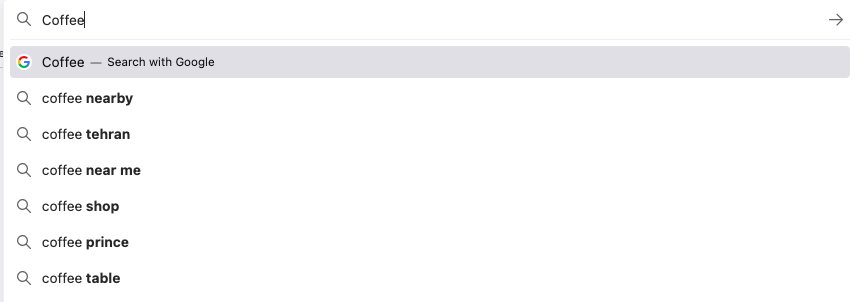
In the image below, we typed “online advertising”. Remember that you may not like the suggested words and don’t offer anything like that at all. Do not worry! In the next steps, we evaluate to isolate the best words.
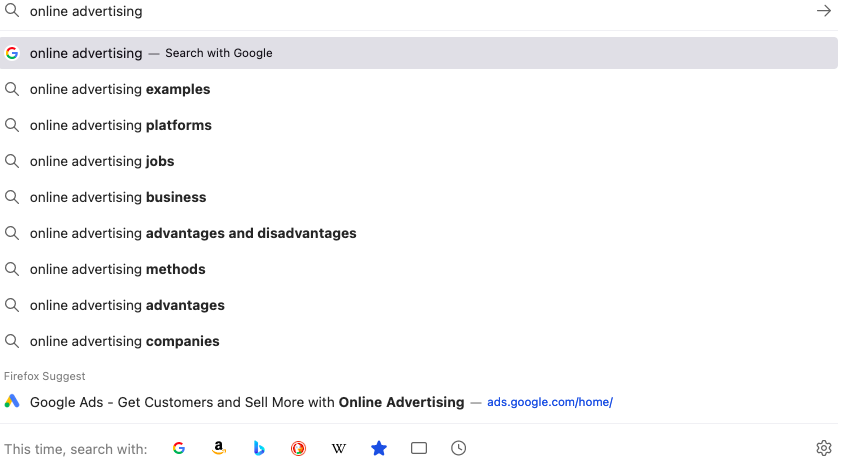
The second thing you need to do is hit enter and scroll to the bottom of the page 🙂 The “Related searches” section of the search results page is a keyword mine.See the result for “coffee” in the image below:

This section may be different depending on the query. In some queries, it is as follows:
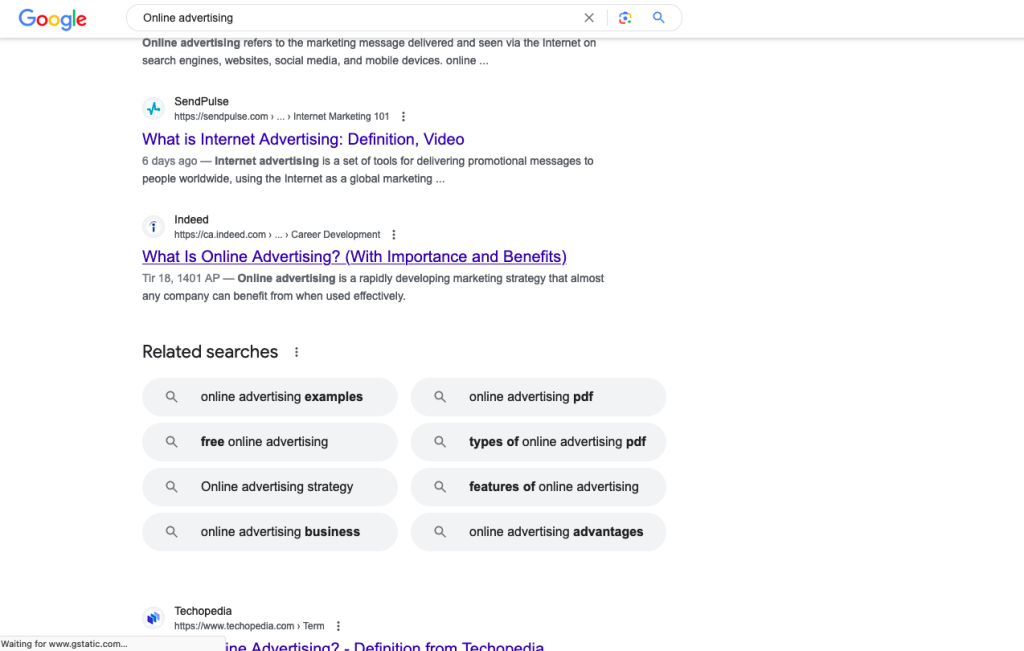
Should an online coffee equipment store target a phrase like “what is coffee”? This comes down to their SEO and content marketing strategy. For example, if they don’t have a blog or product page selling coffee beans, they don’t need to include such a phrase in their list.
Next, we will talk more about how to choose and value words in keyword research.
Use keyword research tools
In this section, we will introduce the most important tool that will be useful to you at this stage and mention the others by their names.Based on experience, we have arranged the tools based on how useful they are in Iran and for Persian words:
- Keyord Planner
- KWfinder
- KeywordTool
- Moz
- SEMrush
- Ubersuggest
- ahrefs
What do these tools do for you? Overall, they help you find hundreds of new keywords, find out how heavy the competition is for each keyword, whether there is commercial intent and advertising competition going on, and what the monthly search volume is.
Well, let’s go to the Keyord Planner. First, enter the Google dashboard.
The appearance of the Google Ads dashboard has changed completely in the last month, and you will probably see something different in other articles (even our own old ones); But the path is the same as before! Only now you have to click on “TOOLS” on the left side of the image.
After that, in the “Planning” section, select the “Keyword Planner” option.
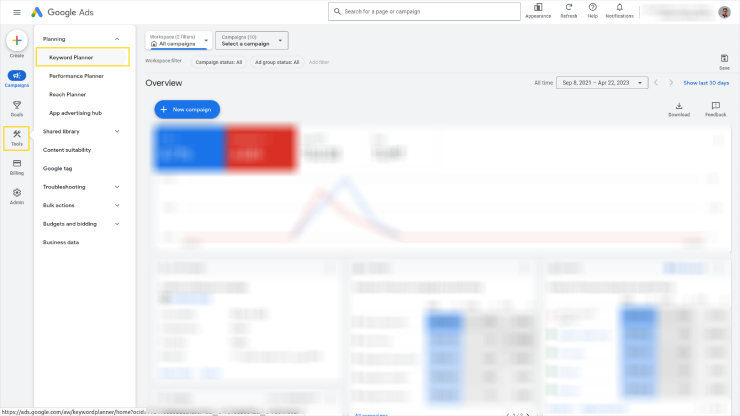
At this stage, you have 2 options:
- Discover new keywords
- get search volume and forecasts
Since we are going to complete our list of keywords, choose the first option. The second option is for when we have a complete list and we just want to check the search volume and other parameters of that list.
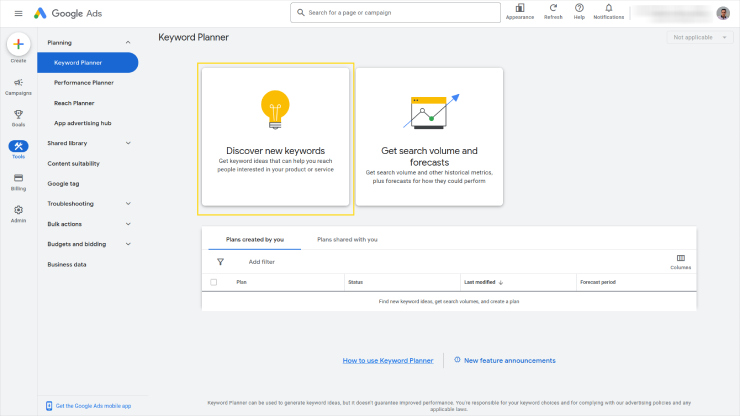
In this step, you must enter the keywords of the first step in the box we specified. :

Find new keywords with Keyword Planner
See the “Start with a website” option? Remember that in the last part of this section, we will tell you that a simple and quick way is to cheat from competitors.
After you enter the words, click “Get Results” and that’s it! This is you and this is a list of 2,144 related words.

Side note: You can also use ChatGPT to save time. Think of it as a utility that gives you a list of keywords very quickly. For Persian language, we recommend using it along with a keyword research tool. The image below is the result of a simple research for a medical journal through this tool.
The third step: analyzing keywords and choosing the best ones
Our list so far is filled with all keywords and phrases; But how to find the keywords of the article? Which word is suitable for the product page? Which word does not work for us at all? Which word should we go to first? What should we invest more in?
This is where you need to check the following parameters:
- Search volume
- Keyword difficulty and level of competition
- CPC (cost per click)
Google’s keyword planner tells you the search volume and the suggested price for each keyword. Of course, if there is commercial competition over that word.
Search volume
First, let’s give an explanation about the search volume of Keyword Planner, which is an average volume for a certain period of time. It does not give you an exact number and it is announced to you in different intervals such as one thousand to 100 thousand or one hundred to one thousand.
Like what you see in the image below:

Tip: To get a more accurate number for words with commercial intent, select all words and click “Add keywords to create plan”. After that, go to the “Forecast” section at the top of the page.
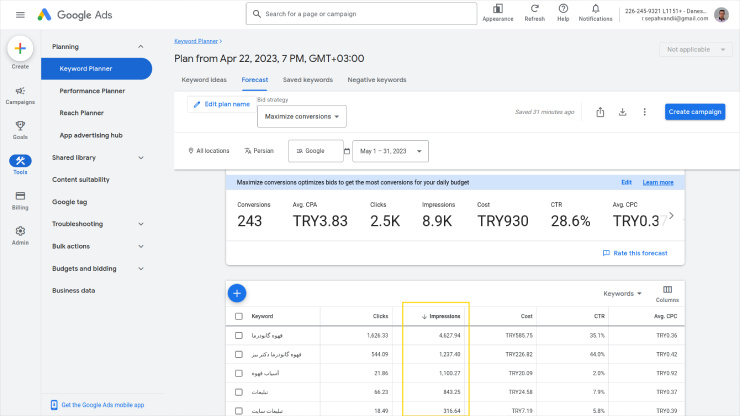
In this section, Keyword Planner predicts the cost of advertising on Google for selected keywords. It should be noted that this number is not exact and the price of each click is calculated at the moment.
Four points are important when analyzing the search volume:
- This number indicates the number of searches and not the number of people who have searched for the desired phrase. A person may search for a keyword several times during the month.
- Search volume is not equal to the traffic you get (even if you rank #1).
- This is the average search volume of a recent year; It means that in April, the word you are looking for may be searched for 120,000 times, and it will rarely be searched for in 11 months. The search volume in this case will be 10,000 per month.
- Search volume varies based on location. Since the country of Iran does not exist in all tools, we have to consider the general location and by choosing the Persian language, we can achieve what we want.
Apart from these 4 items, let us tell you that search volume should not be the only criterion of analysis. Some people only invest in high search volume keywords and get no results? What do you think is the reason?
There are 2 common reasons: they don’t consider the competition and they ignore long tail words!
At the time of launching the site, it is better to focus on keywords with less difficulty – even with low search volume – to gain credibility over time and be able to enter the competition.
On the other hand, ignoring long-tail keywords means losing potential customers whose intentions are ironically known. The longer the keyword, the lower the search volume.
Keyword difficulty
Experienced SEO experts usually measure the difficulty of keywords themselves based on the search results page; That is, they search for each keyword and analyze the content that has been ranked.
Various factors play a role in determining keyword difficulty in their keyword research; such as the following:
- The user’s intention of searching for the keyword
- Type, quality, novelty and relevance of content
- The number and quality of backlinks
- Feature snippet
- Domain validity
The opinion of each expert is different from other experts. For example, maybe one person believes that the validity of the domain is important, and the other may pay more attention to the relevance of the content and its freshness than anything else. This difference may even vary depending on the type of expression they are parsing.
This issue has made the hearts of the owners of SEO tools bleed! But in the end, they decided to determine the difficulty of the keyword based on the validity of the domain, the number of backlinks and the number of referrals.
What should be important to you is this: the higher the difficulty, the harder it is to rank.
It makes sense to invest in less difficult keywords to start with; But this issue should not become a permanent habit. Soon after you build up your credibility, you should go for hard keywords and get backlinks.
our suggestion? Do not use only one parameter, for example, search volume or keyword difficulty, as a criterion. Keyword research should end up with a list of keywords that are valuable to you; Words that bring you customers.
So when the analysis is done, prioritize the keywords based on all the parameters and according to what your business needs. We will talk more about this topic later.
Cost per click
Cost per click (CPC) shows how much advertisers are willing to pay for each keyword. Yes, we also agree with you, this criterion is more useful for keyword research of advertisements in Google, not SEO; But you can look at it as a useful and powerful signal to value keywords.
how about For example, they spent an average of 23.6 liras per click for “Robusta Coffee”. This shows that the target keyword is suitable for attracting customers and selling coffee; Because it indicates that people are looking for it to buy.
But this issue is different for “the difference between Nescafe and coffee”; Because no one has advertised for it at all. This suggests that educational content that provides useful information about the difference between Nescafe and coffee is suitable for this keyword.
Be sure to consider one point: except for some seasonal and trend-related keywords, the search volume of most keywords is the same on average throughout the year; But the amount of CPC that you see in the tools is based on the information of the same time period and running ads.
You’ve crossed out the extras on the list based on the parameters we’ve reviewed so far. Now you can go to the other columns of the keyword research sheet namely intent, content type and priority.
The fourth step: Specifying the user’s intention from the search (Intent)
We have reached the stage that we have mentioned several times; Food serving stage 🙂 If you visit the article “What is content SEO + content SEO steps”, you will see that getting a ranking is more than just following Google’s rules and you must also win the heart of the audience.
Of course, this issue is largely tied to Google’s rules; Because Google tries to provide search results in such a way that the needs of its own customer (the user who searches for the term) are met.
This is where you need to determine with what intention and purpose the user is searching for the terms in your list. Determining the intention of the user determines 2 issues:
- Type of page (main page, product page, blog, tag, online tool, etc.)
- Type of content (guide, webinar, ebook, review, list, etc.)
- viewing angle
The fifth step: prioritizing keywords
So far, by preparing a complete list, you have prepared for content creation and SEO of the site; But where to start? What should we invest in first? This part is perhaps the simplest and at the same time the most personal stage of keyword research.
We cannot wrap one version for everyone; But we suggest you consider the following:
- How much potential does this keyword have? What is its estimated traffic?
- How hard is the keyord? Who are you going to compete with?
- What do you need to create a page? Do you have content that just needs to be updated?
- What is the commercial value and financial benefit of Keyord? What do you get by getting ranked?
The last option can be considered the most important parameter that we should pay attention to when prioritizing. Maybe the search volume is very high and it is easy to get the rank; But this should not mislead you. Does anyone find you who is your customer? Is it useful at all?
Some SEO and content marketing experts consider a funnel and divide it into 3 parts: top, middle and bottom:
- Top of Funnel: People are looking for general information about a topic
- Middle of the Funnel: People are looking to investigate and research available solutions
- Bottom of Funnel: People are looking to buy a specific product or service
After that, they put each word in one of these 3 sections. Obviously, a keyword at the top of the funnel has a high search volume with a low conversion rate; Because it targets people who are not familiar with us.
For example, they put “robusta coffee” at the top, “best robusta coffee beans” in the middle, and “buy robusta coffee beans” at the bottom of the funnel.
But let’s just say that this framework for prioritizing keyword research is sometimes misleading and even tying your hand. Why? For the following 2 important reasons:
First, when someone searches for “robusta coffee,” it doesn’t mean you can’t encourage them to buy your product. It is very common and is done with convincing reasons.
Second, assigning a definitive label for each keyword is wrong; Because it depends on your vision, purpose and type of business.
For example, does “keyword research” benefit our site and the site that offers the same tool? So it can be placed at the top of the funnel and at the bottom of it! It depends on how you look at it.
What words should we invest in first?
SEO experts have a famous saying: it depends! Unfortunately, even though we don’t like it, we have to repeat the same sentence.
- Do you have a new site or a newly established business?
- Do you do the marketing yourself or do you have a large team?
- Are you responsible for converting visitors into customers or do you need to deliver quality leads to the sales team?
- How long do you want to get results?
For example, your job might be to increase traffic as quickly as possible. In this situation, you find keywords with high search volume and low difficulty.
Sometimes, you have to attract leads or even sales, the value of each keyword to the business is stretched, and you have to draw a line around the keywords that generate good traffic.
Don’t forget that keyword research is not the process of finding keywords that are easy to rank for! Keyword research means finding the words and phrases that are most beneficial to your business.
It’s action time!
We’re done with everything you need to know about keyword research. In this article, we have taught you step-by-step keyword research based on experience with examples.
Now you not only know how to find keywords related to your business, but you also learned how to identify chats, prioritize words and choose the best ones.
You can also use this tutorial to find the best keywords for creating content on your blog.
So just enter the pit! If you encounter any problems in the middle of the way, write in the comments section so that we can guide you.
As always, we are waiting to hear your comments 🙂

